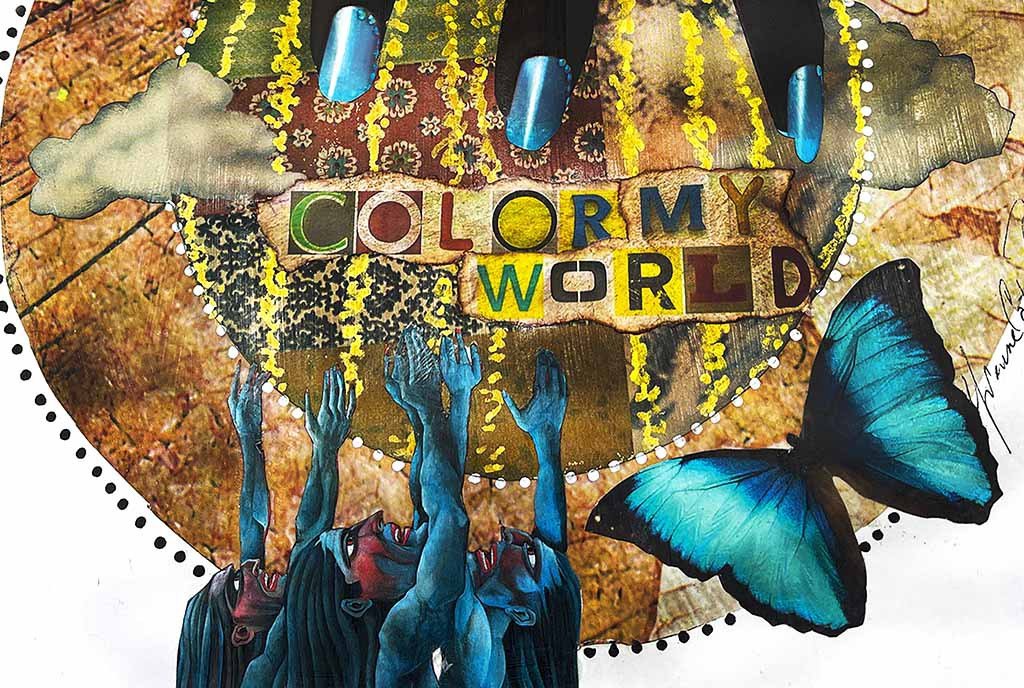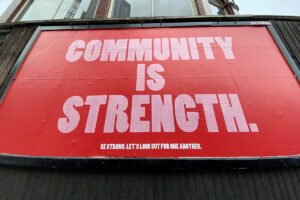
Editors’ note: This piece is from Nonprofit Quarterly Magazine’s summer 2024 issue, “Escaping Corporate Capture.”
May Day 2024 marked the 10-year anniversary of Cooperation Jackson—a network of worker cooperatives and solidarity economy institutions whose mission is to build a vibrant and ecologically regenerative solidarity economy in Jackson, MS, and throughout the southern portion of the United States, as a prelude to a democratic transition toward eco-socialism.1
Cooperation Jackson is the outgrowth of a strategy and plan of action—the Jackson-Kush Plan—that I and several other key organizers and strategists within the Malcolm X Grassroots Movement and the New Afrikan People’s Organization developed between 2004 and 2009.2 In essence, the plan prescribed a “dual power” methodology that combined municipalist and regionalist organizing objectives to build economic and political power for the Black working majorities in the city of Jackson and the Delta regions of Mississippi, Louisiana, Arkansas, and Tennessee. The core components of this strategy called for three fundamental programmatic engagements: (1) building independent people’s assemblies to both hold governments accountable for their policies and actions and autonomously address the various needs of the people through mutual aid and solidarity initiatives; (2) developing and deploying independent electoral vehicles to wield state power and enact non-reformist reforms to further democratize society and enable greater social movement space and maneuverability;3 and (3) employing solidarity economy tools and techniques to radically transform the local and regional economy by socializing the means of production, democratizing productive decision-making and resource mobilization, and centering the needs of the Black working class majority.4
Our accomplishments are minor in comparison to what we would have achieved had we had the full support of the municipal authorities and institutions, buttressed by a beneficial set of policies and procedures that supported local labor, procurement, and production.
Over the course of 10 years, Cooperation Jackson has developed, and is in the process of developing, many projects. It established the Fannie Lou Hamer Community Land Trust, centered in the Capitol Neighbors and Poindexter Park sections of West Jackson, which currently stewards over 45 properties, including 5 housing units, a community center, 2 commercial units, a shopping plaza, and 12 farming plots.5 Cooperation Jackson has also shepherded the creation of 6 local cooperative enterprises: Freedom Farms Cooperative, the Green Team Landscaping Cooperative, the Community Production Cooperative, Zero Waste Cooperative, the Eversville Design and Print Shop Cooperative, and the Catering Cooperative.6 And currently, we are in the process of facilitating the development of the People’s Grocery Cooperative, Chisa Medical Cannabis Dispensary, Chisa Farms (focusing on medicinal cannabis and hemp cultivation), the Black Coffee Cafe and Library Cooperative, and the Ewing Street Ecovillage (also local).
Despite all of these accomplishments, it should be noted that Cooperation Jackson was born prematurely, and the effects of this premature birth have stunted critical aspects of our development over the years. Our accomplishments are minor in comparison to what we would have achieved had we had the full support of the municipal authorities and institutions, buttressed by a beneficial set of policies and procedures that supported local labor, procurement, and production—all of which we would have had access to if Chokwe Lumumba, the mayor of Jackson from July 2013 through February 2014, had lived to usher through the city’s planned development of a solidarity economy.
Unfortunately, Mayor Lumumba died, from obscure causes, on Tuesday, February 25, 2014.7 This date sadly lives on in infamy in Jackson’s social movement circles, because it stunted an emerging solidarity economy in Jackson and deepened our city’s water crisis.8 On this fateful day, the city council was set to approve Mayor Lumumba’s selection of the city’s public works director, who had been deliberately chosen to focus on Jackson’s water crisis by developing an extensive network of public–community partnerships to bypass various state-level limitations and launch a program of autonomous self-taxation to overcome the fiscal challenges confronting the city; it was also set to approve the following policies and programs comprising my operations plan for the development of Jackson’s solidarity economy, distilled from the Jackson-Kush Plan and framed for policy implementation in my capacity as the mayor’s special assistant in the role of the director of special projects and external funding:9
- The establishment of a cooperative division within the city’s economic development department, to provide training and professional development to individuals and groups seeking to develop cooperative enterprises.
- The establishment of a cooperative development fund through the institutionalization of a public– community partnership with various credit unions within the municipality. This was intended to provide assistance and low-to-no-interest loans to developing cooperatives, particularly those representing traditionally underserved and underresourced communities.
- The reformation of the city’s procurement policies, mandating that the city supply a minimum of 50 percent of its resource needs from local vendors, to both stimulate the local economy and reduce the city’s overall carbon emissions.
- The reformation of the city’s contracting policies, mandating that the city grant more than 50 percent of its contracts to local contractors, particularly from business entities drawing from underserved and underrepresented communities.
Had Cooperation Jackson, or an entity like Cooperation Jackson, been able to access these policies and conditions, the scale of our economic and material operations would have had a regional character, as originally intended, instead of the more localized impact we have at present. Why? For starters, if the training institution had been in place, there would have been exponentially more people trained in the basics of how to start and operate a cooperative enterprise than what we have been able to do with our scant resources over the past 10 years. Without an endowment, there is only so much a grassroots organization like Cooperation Jackson can do when it comes to training thousands of people relying on grants and member dues. Further, if we had had access to a locally operated and controlled development fund supporting cooperative initiatives that supply locally produced goods to the municipality—and that provided them with essential labor and services under the aforementioned policies—there is no question that the scale of our projects would be significantly larger than what we have been able to launch and sustain over the last decade.
We note this, because we think our experience provides some key lessons we would like to share with the field regarding how to build a solidarity economy to scale. We also believe that our methodology, which we have called the “Build and Fight Formula,” is unique, in that it both serves to build a solidarity economy to scale and challenges aspects of the employer-versus-employee and owner-versus-nonowner relations that structure the capitalist system of production in which we are currently embedded. (Our arguments—still in formation—are drawn directly from our experience over the past decade as well as from the experiences of numerous other entities in the mutual aid, solidarity economy, trade union, and social justice movements.)
The Build and Fight Formula is fundamentally an argument for building eco-socialism via the democratic practices and tools of the solidarity economy, through the federation of countless self-organized and autonomous projects organized around practices that aggregate power and capacity through broad democratic planning mechanisms on national and international scales. These mechanisms are intended to operate on multiple levels but center on advancing the principles and practices of decolonization, ecological regeneration, material circularity, appropriate technology, and locally focused bioregional production.
The fundamental premise of the Build and Fight Formula is that we must abandon our deficit-based perspective of scale and pivot to a perspective of bounty—one that appreciates the value of a multitude of autonomous organizing projects.
The fundamental premise of the Build and Fight Formula is that we must abandon our deficit-based perspective of scale and pivot to a perspective of bounty—one that appreciates the value of a multitude of autonomous organizing projects engaged in meeting people’s material and social needs and stimulating their productive capacities. We do not need uniformity in the practices and structures that enable our material and social life; rather, we need their coordination along democratic lines of equity and equality.
The Development of Build and Fight
The development of the Build and Fight Formula was inspired by the critical events of the spring and summer of 2020, the following in particular:
- The mass explosion of mutual aid and solidarity efforts that emerged in direct response to the market and to medical shortages created by the COVID-19 pandemic10
- The wave of wildcat strikes triggered by the combination of corporate and government responses to the pandemic11
This does not mean that we aren’t advocating the need for revolutionary ideology and theory; on the contrary, we are arguing for a practical way to get there—through shared practice.
- Social movements’ political responses to the pandemic12
- The historic events of the George Floyd rebellion
These incidents demonstrated not only that the attempt to eviscerate social solidarity during the neoliberal period (the 1970s) was not completely successful but also that the social movement writ large has more connections and capacities than its actors may realize.13 And most important as it relates to this work, the events of 2020 demonstrated that many of the critical skills, practices, processes, and technologies that we need to transform the relations of production (i.e., place ownership of capital into community hands) and social relations overall are in fact in our collective possession and being practiced on a mass scale.
That said, these practices have not been as impactful as they can be because they are not being strategically connected—at least, not in a deliberate and intentional way—due to an all-too-human lack of a shared transformative vision, mission, objectives, and program between and among this large number of partisan actors. As a result, we are proposing not a call for ideological or political unity but rather for programmatic alignment toward a set of shared objectives and principles. Because, as it has been said, it is easier to act your way into new ways of thinking than to think your way into new ways of acting. This does not mean that we aren’t advocating the need for revolutionary ideology and theory; on the contrary, we are arguing for a practical way to get there—through shared practice.
To this end, we have positioned the Build and Fight Formula as a transitional program—one that puts forward a set of practices toward building collective power in the here and now, based on the dynamics of our current space, time, and conditions. At its root, the core aims and objectives center on the following:
(Stated in the negative)
- Ending the regime of private ownership of the means of production
- Ending the regime of commodity production
- Ending the regime of wage labor
- Ending the regime of labor segmentation
- Ending the regimes of hydrocarbon extraction and dependency
- Ending the regimes of settler colonialism, land commodification, imperial extraction, and unequal and undemocratic exchange
(Stated in the positive)
- Socializing production and reproduction14
- Democratizing society
- Socializing all land and housing
- Localizing governance and direct democracy
We believe that if the adherents of the core practices outlined in the Build and Fight Formula can agree on these basic aims and objectives (being mindful that these are only starting suggestions), we can develop a comprehensive political force and social movement that could consciously and deliberately shift and redirect many of the fundamental relations of production that shape our lives.
To do so, we have to start by anchoring ourselves in practices that will enable us to directly assess people’s needs, and work from there to develop systems of production that are based in need, premised on care, and structured around democratically determined roles of social reproduction and adequate energy production and consumption, in order to address issues of ecological scale and impact.
The Formula
Millions of people throughout the United States regularly engage in the following practices:
Sign up for our free newsletters
Subscribe to NPQ's newsletters to have our top stories delivered directly to your inbox.
By signing up, you agree to our privacy policy and terms of use, and to receive messages from NPQ and our partners.
- Community relief and mutual aid work
- Community gardening, community-supported agricultural programs, and small-scale farming
- Worker self-organizing in the form of unionizing drives, radical union reform campaigns, worker-center organizing drives, and worker-cooperative operations and organizing drives
Hundreds of thousands of people throughout the United States are regularly engaged in the following:
- Time banking practices
- Bartering and moneyless exchanges
- Using alternative currencies, including some nonspeculative blockchain experiments
- Enabling community production through tool-lending libraries, volunteer construction brigades, maker-spaces, and fab (fabrication) labs
This motley assortment of millions, we argue, comprises the primary organic, but it is a critical starting point, for the following reasons:
- These practices and arenas of struggle comprise some of the most autonomous yet systemic activities self-organized by working-class, oppressed, and marginalized people.
- The practices rely on dynamics of collective care and social reproduction that are not primarily compelled by subjugation to the law of value within the capitalist system.
- The self-directed and self-managed dimensions of these practices point to logics and methods that could upend the law of value: the ceaseless quest for profits and the accumulation of capital.
However, for this base to realize any dimension of this potential, its constituent forces and the practices in which they are engaging must be linked programmatically. Forging these links is the primary challenge of the Build and Fight Formula. Doing so will no doubt require a major recruitment and education drive. The first major task is reaching a sufficient number of these actors and introducing them to our programmatic vision. The second major task is convincing them to adopt the program and the pursuit of its long-term strategic aims and objectives. Following this, the program would require the actors to expand the scale and scope of their productive activities and base of operations, and be willing to forge links with allied forces participating in the broad range of strategic practices associated with the program.
The Program
The basic programmatic elements of the formula are as follows:
Mutual Aid and Social Reconstruction
Purpose: Collectively meet our material and social needs, build relations of care and accountability, and access our concrete needs.
Food Sovereignty
Purpose: Organize autonomous, self-organized food-production networks capable of producing enough food to address the caloric needs of the people identified through the activities of our mutual aid networks, and transform these networks into self-sustaining entities of noncommodity exchange.
Worker Self-Organization
Purpose: Gather as many workers as wanted/makes sense in trade unions, cooperatives, worker centers, and so forth into networks of worker-managed, collectively owned means of production—so as to construct a new commons (i.e., places of collective stewardship of the resources provided by Mother Earth) that can produce and provide the goods and services we need.
Community Production
Purpose: End our dependence on monopoly manufacturers, energy producers, big tech, and Big Pharma, and autonomously manufacture the appropriate technological instruments required to meet our basic material and social needs within the ecological capacities of our communities and environments.
Self-Defense
Purpose: Defend our autonomous production networks and the gains of our collective labor, as well as our peoples, communities, and environments, from the forces of extraction, exploitation, and authoritarian imposition. Defend against those who seek to keep us embedded in commodity relations and various hierarchies of value that don’t serve us—by, for example, forming Copwatch and anti-Klan/skinhead/neo-Nazi units and outreach brigades.
Peoples’ Assemblies and Planning Councils
Purpose: Determine, through the exercise of direct democracy, the governance of our productive networks and all of the affairs of society, particularly those pertaining to production and reproduction that have been removed from our collective control by capitalism.
***
If we can democratically link all of the social forces that are engaged in these activities, we could create an autonomous value chain and build a coherent movement for economic democracy that would serve as a transformative agent on all scales and scopes of social life in the United States (and beyond). It would not be without its challenges, and it would not be welcomed by many of the dominant economic and social forces in this country—but it would be a force to be reckoned with.
Notes
- Kali Akuno, “It’s Eco-Socialism or Death,” interview by editors, Jacobin, February 15, 2019, com/2019/02/kali-akuno-interview-climate-change-cooperation-jackson.
- “The Story of Cooperation Jackson,” Cooperation Jackson, accessed June 10, 2024, cooperationjackson.org/story; and Kali Akuno, The Jackson-Kush Plan: The Struggle for Black Self-Determination and Economic Democracy (New York: MR Online, July 2020), mronline.org/wp-content/uploads/2020/07/ Jackson-KushPlan.pdf.
- See Amna Akbar, “Non-Reformist Reforms and Struggles over Life, Death, and Democracy,” Yale Law Journal 132, no. 8 (June 2023): 2497–577.
- For more on the solidarity economy, see “Solidarity Economy,” NPQ, April 17, 2023, nonprofitquarterly.org/solidarity-economy/.
- For more details, see Building a Transition City (Jackson, MS: Cooperation Jackson, 2019), cooperationjackson.org/announcementsblog/buildingatransitioncity.
- See Kali Akuno, “Cooperation Jackson at 10: Lessons for Building a Solidarity Economy,” interview by Steve Dubb, News & Media (blog), Cooperation Jackson, January 18, 2024, cooperationjackson.org/blog/npq10yearsofcjdevelopment; and “2019 Year in Review: Resistance and Reflection,” Announcements (blog), December 19, 2019, cooperationjackson.org/announcementsblog/2019yearinreview.
- Douglas Martin, “Chokwe Lumumba, 66, Dies; Activist Who Became Mayor in Mississippi,” New York Times, February 26, 2014, nytimes.com/2014/02/27/us/chokwe-lumumba-66-dies-activist-who-became-mayor-in-mississippi.html.
- Aaron Bartley, “Realizing Mayor Lumumba’s Promise” (blog), Huffington Post, last modified June 21, 2014, huffpost.com/entry/realizing-mayor-lumumbas-sustainability_b_5185933.
- This knowledge is directly derived from my time serving as the director of special projects and external funding for the Lumumba administration from July 2013 until April 2014. See also “The Jackson Rising Statement: Building the City of the Future Today,” in Jackson Rising: The Struggle for Economic Democracy and Black Self-Determination in Jackson, Mississippi,” Kali Akuno and Ajamu Nangwaya (Quebec: Daraja Press, 2017).
- Steve Dubb, “Organizing the Solidarity Economy: A Story of Network Building amid COVID-19,” Nonprofit Quarterly Magazine 28, 2 (Summer 2021): 56–61; Ed Whitfield et al., “Beyond More: The Transformative Potential of Mutual Aid,” NPQ, May 21, 2020, nonprofitquarterly.org/beyond-more-the-transformative-potential-of-mutual-aid/; and Penn Loh and Boone W. Shear, “Fight and Build: Envisioning Solidarity Economies as Transformative Politics,” NPQ, December 14, 2022, nonprofitquarterly.org/fight-and-build-envisioning-solidarity-economies-as-transformative-politics/.
- Michael Sainato, “Strikes erupt as US essential workers demand protection amid pandemic,” The Guardian, May 19, 2020, theguardian.com/world/2020/may/19/strikes-erupt-us-essential-workers-demand-better-protection-amid-pandemic.
- Dorothy Hastings, “‘Abandoned by everyone else,’ neighbors are banding together during the pandemic,” PBS NewsHour, April 5, 2021, pbs.org/newshour/nation/how-mutual-aid-networks-came-together-in-a-year-of-crisis; “Mutual Aid: Building Communities of Care during Crisis and Beyond” (Cooperation Jackson webinar, May 21, 2020), cooperationjackson.org/events-calendar/mutualaidbuildingcommunitiesofcare; and “Hundreds of Mutual Aid Groups Formed in Response to COVID-19. What Comes Next for Them?,” NBCLX, YouTube video, 9:04, accessed June 11, 2024, www.youtube.com/watch?v=c1M-UjjX6C4.
- Steve Dubb, “Of Myths and Markets: Moving Beyond the Capitalist God That Failed Us,” NPQ, April 19, 2023, org/of-myths-and-markets-moving-beyond-the-capitalist-god-that-failed-us/; and Elizabeth A. Castillo, “Restoring Reciprocity: How the Nonprofit Sector Can Help Save Capitalism from Itself,” NPQ, September 30, 2019, nonprofitquarterly.org/restoring-reciprocity-nonprofit-sector-can-help-save-capitalism/.
- See Paul Cammack, “Marx on Social Reproduction,” in Historical Realism 28, 2 (2020): 76–106, brill.com/view/journals/hima/28/2/article-p76_3.xml?language=en.











